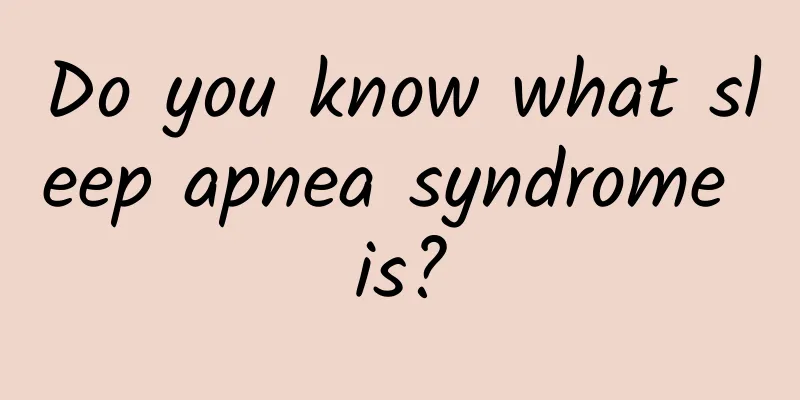Do you know what sleep apnea syndrome is?

|
“Hulu, hulu” Do you often hear someone snoring when they sleep? In daily life, most people have heard this sound, which may come from your family, roommates, friends, and even many people think it is a sound sleep. In fact, snoring is a disease, especially when you wake up during sleep, you should be more alert to whether you have "sleep apnea syndrome"! 1. What is sleep apnea syndrome? Sleep apnea syndrome is a common sleep breathing disorder, which means that during a 7-hour sleep at night, the airflow in the mouth and nose stops for more than 10 seconds and more than 30 times, or the sleep apnea hypopnea index is ≥5 times/hour. Its main sites of disease are the throat, head and nose. 2. What are its symptoms? Sleep apnea syndrome not only affects sleep at night, but also affects daily life or work during the day. The most common symptom during the day is drowsiness. In mild cases, patients may feel sleepy or drowsy while studying or working during the day. In severe cases, patients may fall asleep while eating or talking to others. They may experience headaches in the morning, fatigue during the day, and often feel that sleeping does not relieve fatigue. They may not feel refreshed after waking up and have decreased work efficiency. Abnormal mental and behavioral conditions: decreased attention, memory and judgment. In severe cases, patients may be unable to perform their work. The elderly may suffer from dementia. Common symptoms at night are snoring and apnea, which are often found by people sleeping in the same room or bed with the patient. In addition, there will be palpitations, chest tightness or discomfort in the precordial area; hyperactivity and restlessness during sleep, frequent tossing and turning, involuntary movements of the limbs and even convulsions, mumbling, nocturnal wandering, auditory hallucinations, etc. 3. Causes of sleep apnea syndrome There are many causes of sleep apnea syndrome, mainly caused by narrowing or occlusion of the upper respiratory tract anatomical structure and diseases affecting the respiratory center. (1) Obstructive sleep apnea syndrome The main lesion site is the pharynx. The size of the pharynx is mainly regulated by the contraction of the muscles around the pharynx. When a person goes from awake to sleep, the tension of the muscles around the pharynx decreases. In addition, the gravity factor causes the tongue root and soft palate to move backward when sleeping supinely, making the pharynx relatively narrow, thus causing obstructive sleep apnea syndrome. Nasal obstruction caused by nasal polyps, hypertrophy of the nasal concha, deviation of the nasal septum, nasal tumors, etc. can all cause breathing difficulties and apnea during sleep at night. (2) Central sleep apnea syndrome Its occurrence is mainly related to the increased instability of the respiratory control function of the respiratory center. Primary cases are relatively rare, and common secondary causes include various central nervous system diseases, brain trauma, congestive heart failure, anesthesia and drug poisoning. Nervous system lesions mainly include brainstem and spinal cord lesions caused by vascular embolism or degenerative diseases, poliomyelitis, encephalitis, occipital foramen magnum malformation and familial autonomic dysfunction. 4. Prevention and treatment Family members should pay attention to the patient's breathing rhythm, depth, and snoring during sleep. If the patient holds his breath for a long time, he should be pushed awake. If he has difficulty breathing, purple skin, or pain in the precordial area, he should seek medical attention in time. Do not use sedatives or sleeping pills to help him sleep, so as not to aggravate the condition. The patient's life and work are affected by the disordered sleep structure, and anxiety, irritability, depression and other phenomena often occur. At this time, the patient should actively ask the doctor for relevant knowledge of the disease, build confidence, and believe that actively cooperating with the treatment will have a good effect on his condition. Usually, psychological pressure can be relieved through entertainment methods such as playing games and chess. Family members should also pay more attention to and accompany the patients, and at the same time enlighten the patients through communication and exchange, eliminate the concerns of the patients, and enable the patients to actively cooperate with the treatment. At the same time, monitoring of the disease and a reasonable diet also have a positive effect on this disease. Patients should go to the hospital regularly to let the doctor know the treatment effect so as to adjust the treatment plan in time. |
<<: How to perform rehabilitation treatment for Parkinson's disease?
>>: Want your baby to grow taller? Huaxi experts suggest: Do these 3 things!
Recommend
Symptoms of small intestinal hernia in women
Important reminder: Hernia is more likely to occu...
Is depression just "sentimentality"? In fact, we are not far from it
"Panda Doctor Medical Cartoons" Feed...
Chocolate cyst surgical treatment
Surgical treatment of chocolate cysts is a relati...
A one-month-old baby died while swimming with a collar on. This article explains why doctors do not recommend collars for babies.
Real points: Neck collars are not safe swimming g...
Why do women lose their hair?
The most annoying problem for women is that when ...
What is the reason for the delay of menstruation for more than ten days?
Many women of childbearing age are often troubled...
What are the symptoms of zinc deficiency in women?
If the diet is not properly balanced, it is easy ...
How to deal with muscle soreness after exercise?
Exercise is the cure for everything. Exercise is ...
Why do some people resign suddenly? What are the signs that employees are ready to resign?
Before an employee leaves, he or she will definit...
If the cough is severe and lasts for a long time, you must be careful about this disease
There are a lot of people coughing recently. Some...
What's wrong with green discharge?
Adult women have relatively regular menstrual per...
How to calculate the time for abortion
If a woman has an unexpected pregnancy and wants ...
Pregnancy test strips
Pregnancy is a very pleasant thing for a family. ...
How to self-test pregnancy without pregnancy test stick
How to self-test pregnancy without a pregnancy te...
How to treat breast hyperplasia?
Female breast hyperplasia is very common at prese...









